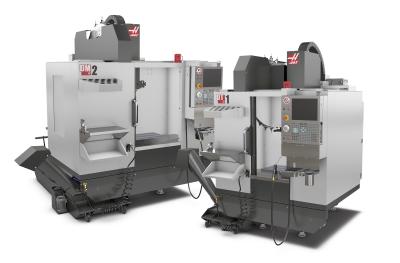
Haas Automation’s popular DT and DM Series Drill/Tap/Mill Centers have been completely redesigned from the castings up to provide more performance and reliability than ever before, with better chip flow, more visibility into the machines, and easier access to parts and fixturing. And best of all, they’re now less expensive.
Haas DT/DM series machines are high-speed, lean-style machining centers that provide high performance in compact footprints that make efficient use of valuable shop floor space. The two series are identical in performance and specification, except for the spindle taper. The DT-1 and DT-2 are 30-taper machines optimized for high-speed drilling and tapping, while the DM-1 and DM-2 offer the advantage of standard 40-taper tooling for more extensive drilling and milling.
Using cutting-edge design and analysis tools, Haas engineers optimized the DT/DM castings to increase rigidity and improve vibration damping, while removing unnecessary mass. To improve ergonomics and increase access to the table for loading/unloading parts and fixtures, the machines’ enclosures were simplified and are slightly larger, with the operator door now centered on the spindle. A large side window provides added visibility into the machine.
To improve chip flow, the new machines feature dual Y-axis washdown nozzles to flush chips toward the chip auger, which now is located at the front of the machine and discharges to the side, like other Haas VMCs. The machines also use the standard 55-gal. coolant tank found on Haas VF series machines, which provides 22 percent more coolant volume than on the previous DT/DM models.
Contact Details
Related Glossary Terms
- centers
centers
Cone-shaped pins that support a workpiece by one or two ends during machining. The centers fit into holes drilled in the workpiece ends. Centers that turn with the workpiece are called “live” centers; those that do not are called “dead” centers.
- coolant
coolant
Fluid that reduces temperature buildup at the tool/workpiece interface during machining. Normally takes the form of a liquid such as soluble or chemical mixtures (semisynthetic, synthetic) but can be pressurized air or other gas. Because of water’s ability to absorb great quantities of heat, it is widely used as a coolant and vehicle for various cutting compounds, with the water-to-compound ratio varying with the machining task. See cutting fluid; semisynthetic cutting fluid; soluble-oil cutting fluid; synthetic cutting fluid.
- gang cutting ( milling)
gang cutting ( milling)
Machining with several cutters mounted on a single arbor, generally for simultaneous cutting.
- milling
milling
Machining operation in which metal or other material is removed by applying power to a rotating cutter. In vertical milling, the cutting tool is mounted vertically on the spindle. In horizontal milling, the cutting tool is mounted horizontally, either directly on the spindle or on an arbor. Horizontal milling is further broken down into conventional milling, where the cutter rotates opposite the direction of feed, or “up” into the workpiece; and climb milling, where the cutter rotates in the direction of feed, or “down” into the workpiece. Milling operations include plane or surface milling, endmilling, facemilling, angle milling, form milling and profiling.
- tapping
tapping
Machining operation in which a tap, with teeth on its periphery, cuts internal threads in a predrilled hole having a smaller diameter than the tap diameter. Threads are formed by a combined rotary and axial-relative motion between tap and workpiece. See tap.
